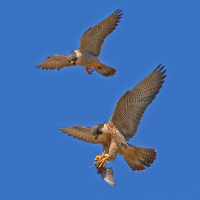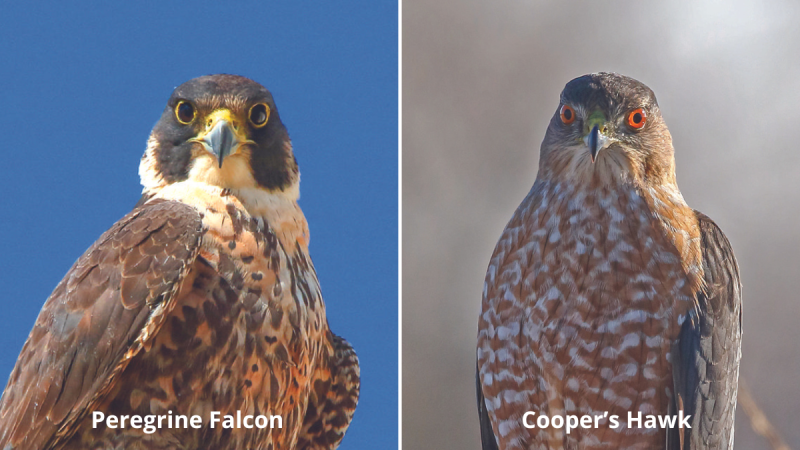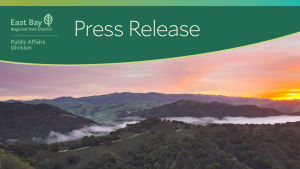Peregrine Falcons in the East Bay
The Peregrine falcon (falco pereginus) is the fastest animal in the world, diving through the air at speeds of up to 240 MPH (you can easily get a speeding ticket for driving 1/3 as fast on the open highway). About the size of a crow, peregrines eat mostly birds which they catch in the air, and it’s exciting to watch them as they acrobatically hunt. Living on every continent except Antarctica, some peregrines have become famous for living in cities.
Tall buildings and bridges are similar to rocky cliffs where Peregrines have historically nested, and where they typically lay a nest of 2-4 eggs on a ledge or shallow scrape. In cities there are often fewer predators of young peregrines like great horned owls, although there are many urban hazards to avoid like power lines, windows, and moving cars. Building owners often wish for a resident peregrine to eat and scare away the pigeons whose droppings make a mess.

Peregrines hunt in many Regional Parks and nest in a few of them. In Diablo Foothills Regional Park, trails to the Castle Rock Recreation Area are usually closed February 1 through August 1 to protect nesting peregrines. They are most commonly seen hunting along our shorelines, so if you notice a flock of shorebirds or pigeons scattering quickly away, search for a predator like a peregrine on the chase. Watch for them tucking their pointy wings back as they hunt, allowing them to aerodynamically reach incredible speeds before they slam into their prey with sharp talons. RIGHT: The smaller male looks down at the larger female who has a meal in her talons.
It was not always so easy to see peregrine falcons in the East Bay. Fifty years ago, they were almost extinct in the United States and in many parts of the world. Only two pair existed in California!
The most important reason for their demise was the widespread use of the insecticide DDT in the 1940s through the 1960s. Its toxins accumulated in animals’ food chains. Top predators like bald eagles, brown pelicans, and peregrine falcons suffered the worst effects: the shells of their eggs became too thin to support the baby birds inside.
Most uses of DDT in the U.S. were banned in 1973. Biologists then began intensive captive breeding programs, and young peregrine falcons were released into the wild for 25+ years. Now there are around 400 self-sustaining pairs in California. The recovery of peregrine falcons and other predatory birds is a huge conservation success, thanks in part to the outlawing of DDT, protection provided by the Endangered Species Act, and the dedicated work of biologists and activists. Peregrine falcons can now be seen throughout much of the Bay Area.
Peregrines often mate for life, though now the population of “floating” (nonpaired) peregrines is high enough that when one individual of a pair disappears, another will often quickly take its place. A pair has been famously nesting on the Campanile at UC Berkeley for five years in a row, and webcams installed in the nesting area allow the public to watch the show live online. During nesting season (late winter through early summer), do an Internet search for peregrine camera, and you will find links to this and other live-streamed nests in the Bay Area and beyond.
It is wonderful to watch peregrine chicks being fed by their parents. And when outside, keep looking skyward for the fastest animal in the world.

To identify a peregrine falcon, look for distinctive black “sideburns” that contrast sharply with the light feathers under the throat. Cooper’s hawks are around the same size as peregrines, though they are more common in our East Bay Regional Parks and in cities. They will hunt birds in the air as well as animals on the ground.






